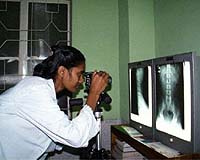 |
Port-Au-Prince (AFP) April 5, 2010 She stopped, chanced a step, then two. But it still felt awkward and little Stephie clung obstinately to her crutches. "She doesn't have enough strength in her other leg," said Fabianna Pierre, the mother of three-year-old girl, who was amputated above the right knee following Haiti's devastating earthquake three months ago. "Bend it! Bend your knee to walk better!" the young mother told her daughter. But it was in vain. Stephie preferred to hop on her good leg despite her shiny new prosthesis. "It's really difficult. She's had this artificial leg for three days now but she still can't do it," added Pierre. "I really wonder how my daughter will go to school." The earthquake that shattered so many lives in this Caribbean nation -- the poorest in the Western Hemisphere -- also tore apart an unfathomable number of limbs. Handicap International puts the number of Haitians who lost a limb to between 2,000 and 4,000. A third of them are children, noted Thomas Leblanc, a prosthetics specialist at a reeducation center opened by the aid group in a shopping district of Port-au-Prince, a neighborhood particularly hit hard by the tremor that left at least 220,000 people dead. The actual number of amputees may be greater, as no systematic count was performed during the first wave of amputations in the immediate aftermath of the quake, said Handicap International spokeswoman Silvia Fommella. The Haitian Health Ministry is conducting a review expected to be completed soon on the number of amputees. Faced with the sheer breadth of the Haitian amputee population, three reeducation and prosthetics manufacturing centers have been opened in the country, which only had one such center before the disaster struck and changed Haitians' lives forever. Drills, screwdrivers, metallic tubes, shoes, pots of grease and countless other miscellaneous objects litter the workshops opened by the French organization a month ago. Handicap International builds six to seven prosthetics each day, around 40 a week, said Handicap worker Albert Saint-Thomas. The centers' waiting rooms are always full and the group is currently caring for some 300 patients. "The temporary prosthetics we are currently building are manufactured much more rapidly (than permanent prosthetics) and allow us to respond to emergencies and help patients stand up on their own," Leblanc said. An adult usually wears two or three temporary prosthetics and a child wears two before receiving permanent ones after several months, according to Fommella. Long-term follow-up is essential for amputees. So there is a renewed focus on training Haitians to replace expatriates rushed to Haiti after the quake. "I have to let go of the illusion I had when I came to receive my prosthetics yesterday," said Brice Canelin, who had his left leg amputated. The 28-year-old had expected he would walk to Petit-Goave, a coastal town located over 60 kilometers (37 miles) southwest of Port-au-Prince. The seminarian was trapped at his study during the quake. He was only rescued over 15 hours later, when a neighbor heard his cries and freed him from the rubble. Three other students died at the same site and another had his arm amputated. "I walk without crutches, but it's still not normal. I need to stick to my learning routine," said a beaming Canelin. Before the quake, he was an avid swimmer and went regularly to the gym. "I will continue to do chest dips and fixed bar training," he vowed.
Share This Article With Planet Earth
Related Links Hospital and Medical News at InternDaily.com
 Internet connects deepest Nepal to 'telemedics'
Internet connects deepest Nepal to 'telemedics'Kathmandu (AFP) March 31, 2010 Patients in rural Nepal will soon be able to consult specialist doctors over the Internet as part of an innovative scheme to improve health care in remote areas of the Himalayan country. Over the next few weeks, the government will begin connecting 25 district hospitals, most of them located in the rugged and inaccessible Himalayas, to specialist consultants in the capital Kathmandu using sa ... read more |
|
| The content herein, unless otherwise known to be public domain, are Copyright 1995-2010 - SpaceDaily. AFP and UPI Wire Stories are copyright Agence France-Presse and United Press International. ESA Portal Reports are copyright European Space Agency. All NASA sourced material is public domain. Additional copyrights may apply in whole or part to other bona fide parties. Advertising does not imply endorsement,agreement or approval of any opinions, statements or information provided by SpaceDaily on any Web page published or hosted by SpaceDaily. Privacy Statement |